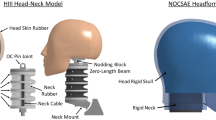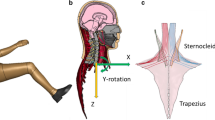Abstract
In helmet impact testing, parameters including acceleration and velocity are measured using instrumented head-neck models that are meant to be mechanically realistic (i.e. biofidelic) stand-ins, or surrogates, for humans. Currently available models of the human neck are designed primarily for application in automotive crash testing, and their applicability in assessment of helmets is often questioned. The object of the present work is to document the mechanical design, repeatability, and biofidelity in low speed impact of a new neck model that we apply with a Hybrid III head. Focusing on Hybrid III head kinematics measured during impacts at 2 to 6 m/s, the co-efficient of variance of repeated measures of kinematics was generally less than 10%. Differences in kinematics between identical copies of the neck was less than 20% when tested with helmets, and less than 7% when the head was not helmeted. In parallel testing using a Hybrid III head-neck, the co-efficient of variance in repeated measures was less than 4% and the kinematics significantly differed from those measured using the new neck. CORAplus scores for the new neck were approximately 0.70 when compared against data for human subjects with passive neck muscles experiencing impact at 2 m/s.








Similar content being viewed by others
References
ASTM F1045-07. Standard performance specification for ice hockey helmets. West Conshohocken, PA, 2007.
Bazarian, J. J., T. Zhu, B. Blyth, A. Borrino, and J. Zhong. Subject-specific changes in brain white matter on diffusion tensor imaging after sports-related concussion. Magn. Reson. Imaging 30:171–180, 2012.
Been, B., M. Philippens, R. de Lange, and M. van Ratingen. WorldSID dummy head-neck biofidelity response. Stapp Car Crash J. 48:431–454, 2004.
Biomechanical Response Requirements of the THOR NHTSA Advanced Frontal Dummy. Boonsboro, MD: General Engineering and Systems Analysis Company, Inc., 2005. https://www.nhtsa.gov/sites/nhtsa.dot.gov/files/thorbio05_1.pdf.
Breedlove, E. L., M. Robinson, T. M. Talavage, K. E. Morigaki, U. Yoruk, K. O’Keefe, J. King, L. J. Leverenz, J. W. Gilger, and E. A. Nauman. Biomechanical correlates of symptomatic and asymptomatic neurophysiological impairment in high school football. J. Biomech. 45:1265–1272, 2012.
Broglio, S. P., J. T. Eckner, H. L. Paulson, and J. S. Kutcher. Cognitive decline and aging: the role of concussive and subconcussive impacts. Exerc. Sport Sci. Rev. 40:138–144, 2012.
Centers for Disease Control and Prevention. Surveillance Report of Traumatic Brain Injury-related Emergency Department Visits, Hospitalizations, and Deaths—United States, 2014. Centers for Disease Control and Prevention, U.S. Department of Heatlh and Human Services, 2019.
Clark, M. D., B. M. Asken, S. W. Marshall, and K. M. Guskiewicz. Descriptive characteristics of concussions in National Football League Games, 2010–2011 to 2013–2014. Am. J. Sports Med. 45:929–936, 2017.
Cohen, J. The Analysis of Variance. In: Statistical Power Analysis for the Behavioral Sciences. Routledge, 2013, pp. 284–288.
Cohen, J. The t Test for Means. In: Statistical Power Analysis for the Behavioral Sciences. Routledge, 2013, pp. 24–27.
Crandall, J. R., D. Bose, J. Forman, C. D. Untaroiu, C. Arregui-Dalmases, C. G. Shaw, and J. R. Kerrigan. Human surrogates for injury biomechanics research. Clin. Anat. 24:362–371, 2011.
Crisco, J. J., R. Fiore, J. G. Beckwith, J. J. Chu, P. G. Brolinson, S. Duma, T. W. McAllister, A.-C. Duhaime, and R. M. Greenwald. Frequency and location of head impact exposures in individual collegiate football players. J. Athl. Train. 45:549–559, 2010.
Daneshvar, D. H., C. J. Nowinski, A. C. McKee, and R. C. Cantu. The epidemiology of sport-related concussion. Clin. Sports Med. 30:1–17, 2011.
Foster, J. K., J. O. Kortge, and M. J. Wolanin. Hybrid III—a biomechanically-based crash test dummy. SAE Trans. 86:3268–3283, 1977.
Gehre, C. and S. Stahlschmidt. Assessment of Dummy Models by Using Objective Rating Methods., 2011.
Gessel, L. M., S. K. Fields, C. L. Collins, R. W. Dick, and R. D. Comstock. Concussions among United States high school and collegiate athletes. J. Athl. Train. 42:495–503, 2007.
Henry, Y. Y., B. M. Knowles, and C. R. Dennison. A test bed to examine helmet fit and retention and biomechanical measures of head and neck injury in simulated impact. J. Vis. Exp. 127:2017.
Hodgson, V. R., M. W. Mason, and L. M. Thomas. Head Model for Impact., 1972. https://doi.org/10.4271/720969.
Hynd, D., P. Depinet, and B. Lorenz. The repeatability and reproducibility of the BioRID IIg in a repeatable laboratory seat based on a production car seat. Traffic Inj. Prev. 14:S95–104, 2013.
ISO 15830-1:2013, Road vehicles—Design and performance specifications for the WorldSID 50th percentile male side-impact dummy, 2013.
Johnson, B., T. Neuberger, M. Gay, M. Hallett, and S. Slobounov. Effects of subconcussive head trauma on the default mode network of the brain. J. Neurotrauma 31:1907–1913, 2014.
Kay, T., D. E. Harrington, R. Adams, T. Anderson, S. Berrol, K. Cicerone, C. Dahlberg, D. Gerber, R. Goka, P. Harley, J. Hilt, L. Horn, D. Lehmkuhl, and J. Malec. Definition of mild traumatic brain injury. J. Head Trauma Rehabil. 8:86–87, 1993.
Langlois, J. A., W. Rutland-Brown, and M. M. Wald. The epidemiology and impact of traumatic brain injury: a brief overview. J. Head Trauma Rehabil. 21:375–378, 2006.
Lessley, D. J., R. W. Kent, J. R. Funk, C. P. Sherwood, J. M. Cormier, J. R. Crandall, K. B. Arbogast, and B. S. Myers. Video analysis of reported concussion events in the National Football League during the 2015–2016 and 2016–2017 seasons. Am. J. Sports Med. 46:3502–3510, 2018.
Linder, A., M. Y. Svensson, J. Davidsson, A. Flogård, P. Lövsund, Y. Håland, L. Jakobsson, and K. Wiklund. Design and validation of the neck for a rear impact dummy (BioRID I). Traffic Inj. Prev. 3:167–174, 2002.
Mainwaring, L., K. M. Ferdinand Pennock, S. Mylabathula, and B. Z. Alavie. Subconcussive head impacts in sport: a systematic review of the evidence. Int. J. Psychophysiol. 132:39–54, 2018.
McAllister, T. W., J. C. Ford, L. A. Flashman, A. Maerlender, R. M. Greenwald, J. G. Beckwith, R. P. Bolander, T. D. Tosteson, J. H. Turco, R. Raman, and S. Jain. Effect of head impacts on diffusivity measures in a cohort of collegiate contact sport athletes. Neurology 82:63–69, 2014.
Meehan, W. P., P. d’Hemecourt, and R. D. Comstock. High school concussions in the 2008–2009 academic year: mechanism, symptoms, and management. Am. J. Sports Med. 38:2405–2409, 2010.
Nelson, T. S., and P. A. Cripton. A new biofidelic sagittal plane surrogate neck for head-first impacts. Traffic Inj. Prev. 11:309–319, 2010.
Newman, J. A., N. Shewchenko, and E. Welbourne. A proposed new biomechanical head injury assessment function—the maximum power index. Stapp Car Crash J. 44:215–247, 2000.
Padgaonkar, A. J., K. W. Krieger, and A. I. King. Measurement of angular acceleration of a rigid body using linear accelerometers. J. Appl. Mech. 42:552–556, 1975.
Parent, D., M. Craig, and K. Moorhouse. Biofidelity evaluation of the THOR and hybrid III 50th percentile male frontal impact anthropomorphic test devices. Stapp Car Crash J. 61:227–276, 2017.
Parent, D., M. Craig, S. Ridella, and J. McFadden. Thoracic biofidelity assessment of the THOR Mod Kit ATD., 2013.
Pellman, E. J., D. C. Viano, A. M. Tucker, and I. R. Casson. Concussion in professional football: location and direction of helmet impacts-Part 2. Neurosurgery 53:1328, 2003.
Pellman, E. J., D. C. Viano, A. M. Tucker, I. R. Casson, and J. F. Waeckerle. Concussion in Professional Football: reconstruction of game impacts and injuries. Neurosurgery 53:799–814, 2003.
Rao, D. P., S. McFaull, W. Thompson, and G. C. Jayaraman. Trends in self-reported traumatic brain injury among Canadians, 2005–2014: a repeated cross-sectional analysis. cmajo 5:E301–E307, 2017.
Reynier, K. A., A. Alshareef, E. J. Sanchez, D. F. Shedd, S. R. Walton, N. K. Erdman, B. T. Newman, J. S. Giudice, M. J. Higgins, J. R. Funk, D. K. Broshek, T. J. Druzgal, J. E. Resch, and M. B. Panzer. The Effect of muscle activation on head kinematics during non-injurious head impacts in human subjects. Ann. Biomed. Eng. 2020. https://doi.org/10.1007/s10439-020-02609-7.
Rowson, S., and S. M. Duma. Development of the STAR evaluation system for football helmets: integrating player head impact exposure and risk of concussion. Ann. Biomed. Eng. 39:2130–2140, 2011.
Rowson, S., and S. M. Duma. Brain injury prediction: assessing the combined probability of concussion using linear and rotational head acceleration. Ann. Biomed. Eng. 41:873–882, 2013.
Rowson, B., S. Rowson, and S. M. Duma. Hockey STAR: a methodology for assessing the biomechanical performance of hockey helmets. Ann. Biomed. Eng. 2015. https://doi.org/10.1007/s10439-015-1278-7.
Saari, A., C. R. Dennison, Q. Zhu, T. S. Nelson, P. Morley, T. R. Oxland, P. A. Cripton, and E. Itshayek. Compressive follower load influences cervical spine kinematics and kinetics during simulated head-first impact in an in vitro model. J. Biomech. Eng. 135:2013.
Sances Jr, A. Dynamic comparison of the hybrid III and human neck. In: Frontiers in Head and Neck Trauma: Clinical and Biomechanical, edited by N. Yoganandan, F. A. Pintar, and S. J. Larson. OHMSHA: IOS Press, 1998, pp. 73–77.
Sances, A., and S. Kumaresan. Comparison of biomechanical head-neck responses of hybrid III dummy and whole body cadaver during inverted drops. Biomed. Sci. Instrum. 37:423–427, 2001.
Scherer, R., D. Cesari, T. Uchimura, G. Kostyniuk, M. Page, K. Asakawa, E. Hautmann, K. Bortenschlager, M. Sakurai, and T. Harigae. Design and Evaluation of the Worldsid Prototype Dummy. Warrendale, PA: SAE International, 2001. https://www.sae.org/publications/technical-papers/content/2001-06-0046/.
Society of Automotive Engineers. SAE J211 Instrumentation for Impact Test—Part 1: Electronic Instrumentation., 2014. https://saemobilus.sae.org/content/j211/1_201403.
Sosin, D. M., J. E. Sniezek, and D. J. Thurman. Incidence of mild and moderate brain injury in the United States, 1991. Brain Inj. 10:47–54, 1996.
Talavage, T. M., E. A. Nauman, E. L. Breedlove, U. Yoruk, A. E. Dye, K. E. Morigaki, H. Feuer, and L. J. Leverenz. Functionally-detected cognitive impairment in high school football players without clinically-diagnosed concussion. J. Neurotrauma 31:327–338, 2014.
Thunert, C. CORA Release 3.6 User’s Manual., 2012.
Vasavada, A. N., J. Danaraj, and G. P. Siegmund. Head and neck anthropometry, vertebral geometry and neck strength in height-matched men and women. J. Biomech. 41:114–121, 2008.
Walsh, E. S., M. Kendall, A. Post, A. Meehan, and T. B. Hoshizaki. Comparative analysis of Hybrid III neckform and an unbiased neckform. Sports Eng. 21:479–485, 2018.
Winkler, E. A., J. K. Yue, J. F. Burke, A. K. Chan, S. S. Dhall, M. S. Berger, G. T. Manley, and P. E. Tarapore. Adult sports-related traumatic brain injury in United States trauma centers. Neurosurg. Focus 40:E4, 2016.
Xu, L., J. Jensen, K. Byrnes, A. Kim, V. Agaram, K. L. Davis, R. W. Hultman, G. Kostyniuk, M. E. Marshall, H. Mertz, G. Nusholtz, S. Rouhana, and R. Scherer. Comparative performance evaluation of THOR and hybrid III. SAE Trans. 109:284–308, 2000.
Yu, H. Y., and C. Dennison. A laboratory study on effects of cycling helmet fit on biomechanical measures associated with head and neck injury and dynamic helmet retention. J. Biomech. Eng. 141:2018.
Acknowledgments
The authors wish to acknowledge the equal contributions of the three lead authors on this manuscript.
Funding
Financial support for the following is gratefully acknowledged from several sources: The Natural Sciences and Engineering Research Council of Canada (Discovery and Engage Grants); The Canada Foundation for Innovation; The Canada Research Chairs Program; and the Faculty of Engineering at the University of Alberta.
Author information
Authors and Affiliations
Corresponding author
Additional information
Associate Editor Joel Stitzel oversaw the review of this article.
Publisher's Note
Springer Nature remains neutral with regard to jurisdictional claims in published maps and institutional affiliations.
Rights and permissions
About this article
Cite this article
MacGillivray, S., Wynn, G., Ogle, M. et al. Repeatability and Biofidelity of a Physical Surrogate Neck Model Fit to a Hybrid III Head. Ann Biomed Eng 49, 2957–2972 (2021). https://doi.org/10.1007/s10439-021-02786-z
Received:
Accepted:
Published:
Issue Date:
DOI: https://doi.org/10.1007/s10439-021-02786-z




